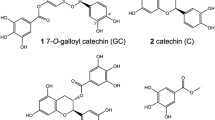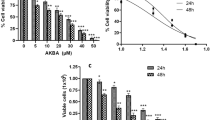ABSTRACT
Purpose
We evaluated the chemotherapeutic effect of water extract of white cocoa tea (WCTE) against human prostate cancer (PCa) in vitro and in vivo.
Methods
Cell viability and cell cycle distribution were determined by MTT assay and flow cytometry, respectively. Western blotting was performed to determine changes in levels of various proteins. Effect of WCTE was determined in athymic nude mice implanted with PC-3 cells.
Results
Treatment with WCTE (100–150 µg/ml) inhibited cell proliferation, which correlated with G2/M phase arrest in PC-3 cells. WCTE treatment to PC-3 cells resulted in (1) induction of WAF1/p21 and KIP1/p27, (2) decrease in cyclins D1, D2 and E, (3) decrease in cyclin-dependent kinase (cdk) 2, 4 and 6, (4) induction of Bax and down-regulation of Bcl-2, (5) decrease in procaspase-3, -8, (6) inhibition of nuclear translocation and phosphorylation of NF-κB and activation of IKKα, and (7) inhibition of phosphorylation and degradation of IκBα. Oral administration of WCTE (0.1 and 0.2%, wt/vol) to athymic nude mice resulted in greater than 50% inhibition of tumor growth. There was a decrease in expressions of cyclin D1, Bcl-2 and p-NF-κB and an increase in WAF1/p21 and Bax in tumor tissues of mice.
Conclusion
WCTE can be a useful chemotherapeutic agent against human PCa.




Similar content being viewed by others
Abbreviations
- cdk:
-
cyclin-dependent kinase
- EGCG:
-
Epigallocatechin gallate
- GCG:
-
Gallocatechin gallate
- MTT:
-
Thiazolyl Blue Tetrazolium Bromide
- NF-κB:
-
Nuclear factor kappa B
- PCa:
-
Prostate cancer
- WCTE:
-
White cocoa tea extract
REFERENCES
Jemal A, Siegel R, Ward E, Hao Y, Xu J, et al. Cancer statistics. CA Cancer J Clin. 2009;59:225–49.
Pu YS, Chiang HS, Lin CC, Huang CY, Huang KH, et al. Changing trends of prostate cancer in Asia. Aging Male. 2004;7:120–32.
Syed DN, Khan N, Afaq F, Mukhtar H. Chemoprevention of prostate cancer through dietary agents: progress and promise. Cancer Epidemiol Biomarkers Prev. 2007;16:2193–203.
Siddiqui IA, Saleem M, Adhami VM, Asim M, Mukhtar H. Tea beverage in chemoprevention and chemotherapy of prostate cancer. Acta Pharmacologica Sinica. 2007;28:1392–408.
Ahmad N, Feyes DK, Nieminen AL, Agarwal R, Mukhtar H. Green tea consitituent epigallocatechin-3-gallate and induction of apoptosis and cell cycle arrest in human carcinoma cells. J Natl Cancer Inst. 1997;89:1881–6.
Adhami VM, Siddiqui IA, Ahmad N, Gupta S, Mukhtar H. Oral consumption of green tea polyphenols inhibits insulin-like growth factor-I-induced signaling in an autochthonous mouse model of prostate cancer. Cancer Res. 2004;64:8715–22.
Adhami VM, Siddiqui IA, Sarfaraz S, Khwaja SI, Hafeez BB, et al. Effective prostate cancer chemopreventive intervention with green tea polyphenols in the TRAMP model depends on the stage of the disease. Clin Cancer Res. 2009;15:1947–53.
Syed DN, Afaq F, Kweon MH, Hadi N, Bhatia N, et al. Green tea polyphenol EGCG suppresses cigarette smoke condensate-induced NF-kappaB activation in normal human bronchial epithelial cells. Oncogene. 2007;26:673–82.
Xie BF, Liu ZC, Pan QC. The anticancer effect and anti-DNA topoisomeraseIIeffect of extracts of camellia ptilophylla chang and camellia sinensis. Chin J Cancer. 1992;11:424–8.
Xian LJ, Liu ZC, Pan QC, Li HX. The inhibitory effect of extract of camellia sinensis and extract of camellia ptilophylla chang of DNA polymerase of ehrlich ascite carcinoma cells. Chin J Cancer. 1997;16:334–7.
Kurihara H, Shibata H, Fukui Y, Kiso Y, Xu JK, et al. Evaluation of the hypolipemic property of Camellia sinensis Var. ptilophylla on postprandial hypertriglyceridemia. J Agric Food Chem. 2006;54:4977–81.
He RR, Xie G, Yao XS, Kurihara H. Effect of cocoa tea (Camellia ptilophylla) co-administrated with green tea on ambulatory behaviors. Biosci Biotechnol Biochem. 2009;73:957–60.
Yang XR, Ye CX, Xu JK, Jiang YM. Simultaneous analysis of purine alkaloids and catechins in Camellia sinensis, Camellia ptilophylla and Camellia assamica var. kucha by HPLC. Food Chem. 2007;100:1132–6.
Peng L, Song XH, Shi XG, Li JX, Ye CX. An improved HPLC method for simultaneous determination of phenolic compounds, purine alkaloids and theanine in Camellia species. J Food Compost Anal. 2008;21:559–63.
Wang ZY, Huang MT, Ferraro T, Wong CQ, Lou YR, et al. Inhibitory effect of green tea in the drinking water on tumorigenesis by ultraviolet light and 12-o-tetradecanoylphorbol-13-acetate in the skin of SKH-1 mice. Cancer Res. 1992;52:1162–70.
Gupta S, Hastak K, Ahmad N, et al. Inhibition of prostate carcinogenesis in TRAMP mice by oral infusion of green tea polyphenols. Proc Natl Acad Sci USA. 2001;98:10350–5.
Adhami VM, Malik A, Zaman N, Sarfaraz S, Siddiqui IA, et al. Combined inhibitory effects of green tea polyphenols and selective cyclooxygenase-2 inhibitors on the growth of human prostate cancer cells both in vitro and in vivo. Clin Cancer Res. 2007;13:1611–9.
Hastak K, Gupta S, Ahmad N, Agarwal AK, Agarwal ML, et al. Role of p53 and NF-κB in epigallocatechin-3-gallate-induced apoptosis of LNCaP cells. Oncogene. 2003;22:4853–9.
Hartwell LH, Kastan MB. Cell cycle control and cancer. Science. 1994;266:1821–8.
Vermeulen K, Berneman ZN, Van Bockstaele DR. The cell cycle: a review of regulation, deregulation and therapeutic targets in cancer. Cell Prolif. 2003;36:165–75.
Bucher N, Britten CD. G2 checkpoint abrogation and checkpoint kinase-1 targeting in the treatment of cancer. Br J Cancer. 2008;98:523–8.
Devault A, Cavadore JC, Fesquet D, et al. Concerted roles of cyclin A, cdc25+ mitotic inducer, and type 2A phosphatase inactivating the cyclin B/cdc2 protein kinase at the G2/M phase transition. Cold Spring Harb Symp Quant Biol. 1991;56:503–13.
van den Heuvel S, Harlow E. Distinct roles for cyclin dependent kinases in cell cycle control. Science. 1993;262:2050–4.
Hockenbery DM, Oltvai ZN, Yin XM, Milliman CL, Korsmeyer SJ. Bcl-2 functions in an antioxidant pathway to prevent apoptosis. Cell. 1993;75:241–51.
Reed JC. Regulation of apoptosis by Bcl-2 family proteins and its role in cancer and chemoresistance. Curr Opin Oncol. 1995;7:541–6.
Revelos K, Petraki C, Gregoakis A, Scorilas A, Papanastasiou P, et al. Immunohistochemical expression of Bcl-2 is an independent predictor of time-to-biochemical failure in patients with clinically localized prostate cancer following radical prostatectomy. Anticancer Res. 2005;25:3123–33.
Nicholson DW. Caspase structure, proteolytic substrates, and function during apoptotic cell death. Cell Death Differ. 1999;6:1028–42.
Grutter MG. Caspases: key players in programmed cell death. Curr Opin Struct Biol. 2000;10:649–55.
Zimmermann KC, Bonzon C, Green DR. The machinery of programmed cell death. Pharmacol Ther. 2001;92:57–70.
Islam S, Islam N, Kermode T, Johnstone B, Mukhtar H, et al. Biochem Biophys Res Commun. 2000;270:793–7.
Hayakawa S, Saeki K, Sazuka M, Suzuki Y, Shoji Y, et al. Biochem Biophys Res Commun. 2001;285:1102–6.
Gupta S, Hastak K, Afaq F, Ahmad N, Mukhtar H. Essential role of caspases in epigallocatechin-3-gallate-mediated inhibition of nuclear factor kappa B and induction of apoptosis. Oncogene. 2004;23:2507–22.
Siddiqui IA, Zaman N, Aziz MH, et al. Inhibition of CWR22Rv1 tumor growth and PSA secretion in athymic nude mice by green and black teas. Carcinogenesis. 2006;27:833–9.
ACKNOWLEDGEMENTS
This work is supported by Chinese Government Scholarship to Li Peng to conduct research work in the laboratory of Prof. Hasan Mukhtar at University of Wisconsin-Madison and by United States Public Health Service Grants RO1 CA 78809, RO1 CA 101039, RO1 CA 120451 and P50 DK065303.
Author information
Authors and Affiliations
Corresponding author
Rights and permissions
About this article
Cite this article
Peng, L., Khan, N., Afaq, F. et al. In Vitro and In Vivo Effects of Water Extract of White Cocoa Tea (Camellia ptilophylla) Against Human Prostate Cancer. Pharm Res 27, 1128–1137 (2010). https://doi.org/10.1007/s11095-010-0052-7
Received:
Accepted:
Published:
Issue Date:
DOI: https://doi.org/10.1007/s11095-010-0052-7




